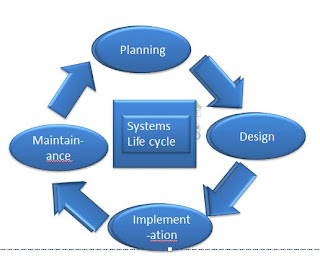System: a collection of things working together to accomplish some defined end. A computer is a system, as is a computer network, as is a piece of software, as is a production line or distribution platform. Systems can be small or global in scope.
Analysis: the process of breaking things into smaller and smaller parts in order to understand how the parts work together to accomplish an end.
Systems Analysis: Breaking systems into their parts in order to understand how each part contributes to the whole.
The discipline of systems analysis consists of a variety of techniques to help developers get a handle on complex systems in a way that will minimize expensive failures.
Every system has a life cycle:

Planning: This begins with identifying a problem or weakness in the current system. Something about the current system is no longer adequate to the business needs. It may be slowing down because of an increase in the volume of activity. Conditions may have changed so that it is no longer able to do all that needs to be done. There may be new opportunities that should be taken advantage of. Planning first identifies what it is that needs to be done. Then it identifies some ways to do those things. It accesses feasibility of the various options and selects one to develop.
Design: Once one is selected the design process begins. In the design process developers identify all the requirements. They break the problem into smaller parts to make it easier to understand. Then they develop and test those parts.
Implementation: When the system is ready and meets all the requirements, it is put into production. This can be a tricky and complex problem with high stakes. There are several stratagies for putting it into production. A new system can be implemented little by little, testing each part as it is put into production. It can be put parallel to the old system and gradually phased in to be the only system. Or it can just be put in full production and hope for the best. Each method has its pros and cons.
Maintainance: When the system is in production it will need occassional fixes as bugs are discovered. Small adjustments to its processes can be added or subtracted as needed. But eventually, the system will become obsolete and the cycle will return to planning.
It should be noted that these sections of the life cycle are not as discrete as they appear in the diagram.
There are several broad aspects of systems analysis:
One of them focuses on project planning, and project management. This is a crucial aspect of systems analysis, but I am focusing on another aspect--the design aspect, especially object oriented design. We are going to work with the aspects of systems analysis that are closest to programming, specifically UML.
No comments:
Post a Comment